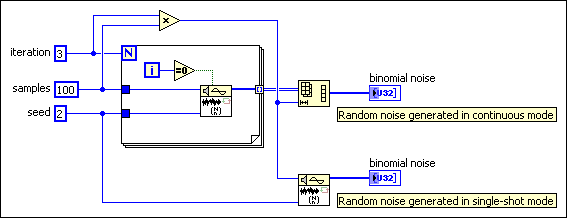Binomial Noise VI
Owning Palette: Signal Generation VIs
Requires: Full Development System
Generates a binomially-distributed, pseudorandom pattern whose values are the number of occurrences of an event, given the probability of that event occurring and the number of trials.

 Add to the block diagram Add to the block diagram |
 Find on the palette Find on the palette |






 equals
equals  . To generalize, P(X = i) is the probability that i of the n trials equals 1, and n – i equals zero. When n equals 1, the Binomial noise degenerates into
. To generalize, P(X = i) is the probability that i of the n trials equals 1, and n – i equals zero. When n equals 1, the Binomial noise degenerates into  , of the pseudorandom sequence:
, of the pseudorandom sequence:
